Learn a few simple tips to make un-pho-gettable, pho-lavorful pho like a pro.
When I first moved to Hawaii, I discovered Vietnamese noodle soup – more specifically Pho. The first time I had it was in Honolulu’s Chinatown where a friend had recommended we go to this one restaurant that specialized in Pho. When we got there, there was a line out the door—a sure sign that the food was going to be good. And it was and my love affair with Pho started.
Un-pho-gettable
When we got to San Jose, I discovered that the Vietnamese population here was even bigger and we got exposed to so many more Vietnamese dishes. But even as I learned to love many other dishes, I had to have my pho every so often and every time I sat down to a bowl of Pho, that first sip of the broth would have me sighing contentedly. There was just something so heartwarming about the soup—the spices and herbs along with the hearty meat stock marrying together and creating a fragrance unlike anything else.
Even though beef pho is more common, Nate and I will sometimes order chicken pho (pho ga). The broth is often cleaner but with a more distinctive sweetness from using chicken stock, I suppose. Whatever it is, it is just as compelling as beef pho. We love them both equally. How about you? Which do you pre-pho?
Looking Pho-ward
Now that I’m in Malaysia, I find that Vietnamese food is not as popular here. I suppose that Malaysians have so many noodle dishes already that people are not as impressed by the subtleties of pho (or maybe they just aren’t aware of it). Our family misses this noodle soup quite a bit (Daniel and Esther gave a cheer when they heard I was making it). Thankfully, we brought most of the spices we would need to make it ourselves.
However, I have never made beef pho. Every so often, I have made chicken pho in California. That being the case, I decided that I would save the more daunting task of cooking beef pho for another occasion (it seems more daunting because beef stock is very unfamiliar to me). So today, I went to the market to get all that I needed for chicken pho.
The first thing I did was to make sure I got myself a really good chicken (I bought a free range chicken) and some extra chicken bones (I had saved some from previous cooks). Then I went looking for the fresh herbs and beansprouts that I would need for the garnishing. The noodles were an easy acquisition since pho noodles are very similar to kuay teow and I could find fresh ones at the market.
Everything else I already had at home in my pantry so I was set to go.
Can We Say Pho-lavor?
Before I first made pho, I heard from friends that making pho broth is a real production that takes days. But I learned how to make this dish from a student friend in my graduate student days. She made it look so simple, basically just boil some chicken with spices and aromatics that had been charred in a fire, add some seasonings, garnish with fresh herbs and dashes of lime and fish sauce. She alone convinced me that pho could be a simple meal and soon I was making it like a pro.
The one key thing that I learned from her was that the flavors in pho formed from the charring of the spices (cinnamon, black cardamom, cloves, star anise) and aromatics (ginger and onion). When we were in the dorm, we didn’t have access to a gas stove so we just broiled these ingredients in the oven till they had blackened in some parts. The charring lends the soup stock more depth and color.
Charring Onion and Ginger
Once that is done, just put all the spices in a large stock pot and add the chicken and chicken bones. Fill with enough water to cover the chicken (about 15 cups). You want to have enough water at the start so that you don’t have to add water later which will then dilute the flavors. The stock is then simmered for a long time to extract the most flavor out of the chicken bones. You do want to take the whole chicken out midway (around 30-40 minutes) and cool it before removing the meat. The carcass is then tossed back into the stock to simmer some more.
As for seasonings, I find that you need to season quite strongly as the noodles themselves are very bland. I normally add salt and fish sauce and also a little bit of chicken bouillon. I also add some rock sugar into the stock to sweeten it up a little (I learned this from a former ESL student who was a cook at a popular pho restaurant in San Jose, and Andrea Nguyen also recommends it). When you taste it, it should be more strongly flavored than a normal soup. This will balance out once you add the noodles and beansprouts.
Pho-nishing Touches
The rest of the dish is really pretty simple. As the stock is simmering, just assemble the garnishes—beansprouts, Thai basil, sawtooth leaf herb, some jalapeno or other chilli peppers, and lime. Prepare the noodles—if you have dry ones, blanch in hot water quickly to soften, or if using fresh noodles, just give a quick rinse in cold water. Cut up the chicken meat into bite sized pieces.
One other trick that I have when serving I learned from observing the hawker stall vendors here that serve noodle soup. Ladle some hot soup into your assembled bowl of noodles and beansprouts and herbs, drain the soup back into the soup stock (which should be boiling hot by the way). Then ladle the soup back into the noodles again. This is to blanch and heat all the ingredients thoroughly and ensure that the soup itself is piping hot when served.
Finish by adding a squirt of lime and peppers to your taste. Serve hoisin and sriracha on the side if you like (I mainly use this as a dipping sauce for my meats but omitted it this time as the chicken was tasty enough without it)
Chicken pho (Pho Ga) recipe
serves 6-8
Ingredients:
1 whole free-range chicken (the better the chicken, the more superior the stock), about 1.5 kg (3-4lbs)
additional chicken bones (I used some chicken feet and neck and also an extra 2 whole rib bones)
2 large yellow onions, skin removed
3 inches ginger, skin removed
3-4 star anise
3-4 cloves
1 inch stick of cinnamon (thank you White on Rice couple for providing us with authentic Vietnamese cinnamon)
1-2 black cardamom pods, slightly pounded to allow flavors to be released
15 cups water
2 Tbsp salt
3 Tbsp fish sauce
1 inch chunk rock sugar
1 tsp chicken bouillon
1 tsp ground black pepper
Garnishes:
2 cups beansprouts (I err on the side of more in case some people like more sprouts in their bowl, whatever is leftover can be used in a stirfry or in making Vietnamese summer rolls later)
1 bunch Thai basil, washed
8 sawtooth herb leaves (optional)
2 limes, quartered
1 Jalapeno chilli, sliced
4-5 green onions, diced
Hoisin sauce and Sriracha sauce on the side
1 kg (about 2 lbs) fresh pho noodles (koay teow noodles) or a packet of dried rice noodles that have been softened in hot water
Method:
1. Char the onions and ginger over an open flame till they have dark brown bits all over. Do the same with the star anise, cloves, cinnamon, and cardamom (I just hold it with my tongs under the fire for a few seconds).
Charred Onion, Ginger, Cinnamon, Star Anise, Black Cardamom, Cloves
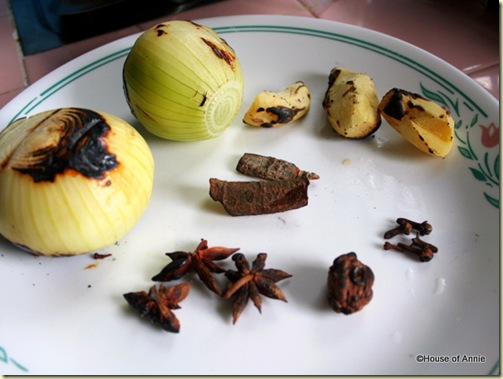
2. Put the charred aromatics into a large pot with the chicken, chicken bones and water.
3. Bring to a boil. Skim off the scum that has risen to the top. Turn fire down to low and let simmer for about 2 1/2 to 3 hours.
4. About 30-40 minutes into the simmer, take out whole chicken and rinse in cold water to stop cooking. Drain and let it dry and cool. When cool enough to handle, remove wings, legs, thighs and cut off the breast meat. Return the rib carcass to the stock pot. Place the meats (uncut) on a platter and keep cool until needed.
5. Clean and wash beansprouts, sawtooth leaf herb, and Thai basil. Prepare plate with the garnishes, green onions, lime wedges and chillies, if using.
Garnishes for Pho: Thai Basil, Bean Sprouts, Sawtooth Herb, Lime Wedges
6. Prepare noodles (wash with cold water if using fresh noodles, and soften dried noodles in hot water).
7. Slice chicken into bite sized pieces. Remove dark meat from bone.
8. When ready to eat, taste broth and adjust seasonings if needed. Remember that the stock should be strongly flavored (it should have a nice saltiness with an underlying sweetness). Put in freshly ground black pepper and bring stock back to a rolling boil.
9. Assemble bowl: place noodles, sprouts, herbs and chicken on the bowl. Ladle hot stock into bowl and then drain back into stock pot, without letting the other ingredients fall in (use a slotted spoon to hold them back). Re-ladle stock into soup bowl. Finish with a handful of green onions.
10. Squirt lime and add chillies to individual taste.
Pho Ga: Chicken Pho Noodle Soup
Go Pho It! (i.e. Enjoy)
Cheers, Annie
Since we used White on Rice Couple’s Vietnamese cinnamon in this dish, we are entering this post in Weekend Herb Blogging #209, hosted by Paul Chen’s Food Blog and administered by Cook Almost Anything.
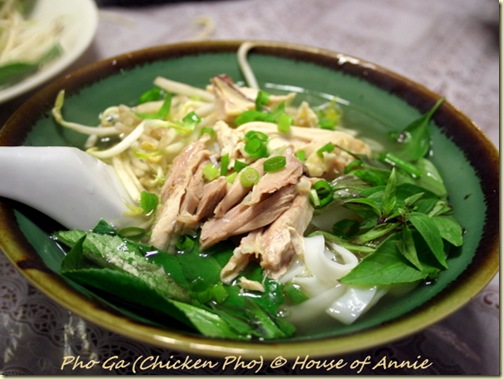
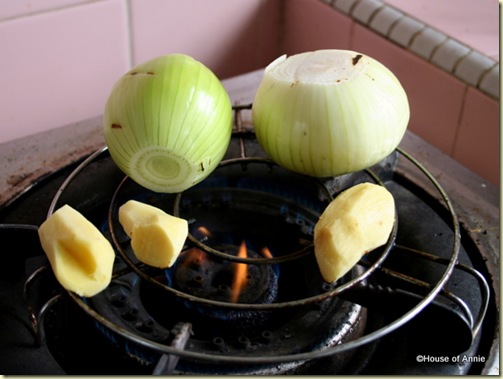

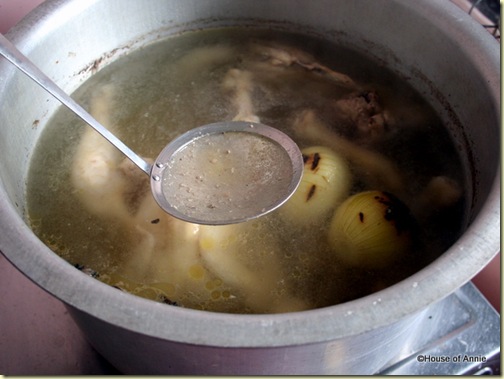
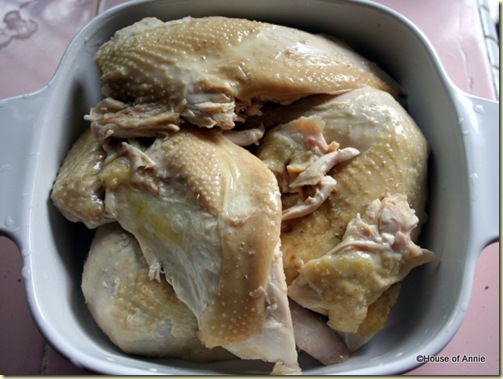

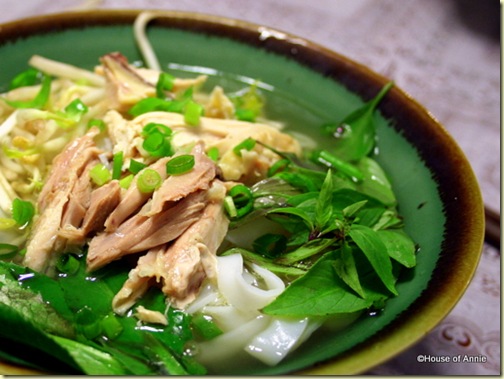
>Girl, if you had any idea how much I have been craving pho (more than usual right now!) Problem is, there are no Vietnamese restaurants within an hour's drive of here. Having the recipe is inspiring, but I have no idea where to get the noodles. However, we just discovered a spice shop nearby! Maybe, just maybe they will have the black cardamom and star anise. I might get my pho after all. . .and if not, at least I have your pictures!
>Hi Annie. I'm not sure whether Kuching people like Vietnamese food. A few Vietnamese restaurants have opened and closed. Maybe it's because the food wasn't good enough.
I love Pho, but more the beef version due to it's richer flavour. Melbourne has a really great Vietnamese place which serves the BEST !
Your Pho Ga looks delicious. I personally think the Ipoh Hor Fun is quite close to Pho in both taste, texture and presentation.
>That's just amazing! I love pho and though I have never made it myself, my Vietnamese friend always makes the perfect one. 😀
>Annie, your pho ga is so beautiful and fresh. You make it look so easy to make the soup. I really admire your skill. Wendy
>@all – thanks for your comments!
@Queenie – I've updated a post to include an Amazon link where you can buy the dried rice noodles.
@Borneoboy – Sorry to hear that the VN restaurants closed down. I wonder what it is about Vietnamese food that Kuchingites don't like?
We'll have to make a stop in Melbourne and compare their VN food to San Jose's!
Hm, Ipoh hor fun maybe close in texture and presentation but taste I'm not so sure about.
@Ben – thanks!
@Wendy – thank you.
>I am loving this big bowl of noodle soup pho-sure! 😉
>Phở-Tak-Ténġ!
>I have tried Pho Bo but not Pho Ga yet. I do not have a gas stove at home, we have electric stove so cannot cook the onion that way unfortunately. Your Pho Ga looks great, I will make it too one day soon too!
Sorry I deleted the last comment, can you delete it from your side. I hv mispressed the button.
>Hi Annie, Your dish looks some beautiful. I like beef pho and the chicken pho I had before was not so great, mainly because they did not put much meat in it and only serve with bean sprouts. I spent Veteran's Day looking for the Vietnamese cinnamon sticks and cardamon. I went to many Chinese markets and herb stores. I finally found one herb store which has a herb dictonary and found what cardamon pod is in Chinese. Once I have the Chinese name, they know what I am talking about. I will try the pho ga and let you know. Thanks for sharing your recipe.
>Hi annie! Sorry about the Huli Huli Chicken post! I was editing it earlier to have the macaroni salad on that post instead of a separate one and forgot to re-publish!!! Duh! Thankfully I just found a great Pho recipe as a result. Must have been meant to be. Thanks for your interest and pointing out the missing post.
>Hi Annie, I made the pho ga for dinner today. I did not want to wait after I bought fresh basil and sawtooth leaves. Not sure how long they will last. I did not want to work on a chicken so I used chicken powder and 4 big drum-sticks and made a 1/2 portion. The flying sparks from the charring scared me a little bit. It turns out light and delicious.
>@Janet – you can roast the aromatics in the oven.
@Dani – no problems. Welcome to our site. Hope you have a chance to try our pho recipe!
@Wendy – I'm impressed by your tenacity! I should try taking a pic of a packet of cardamom to add to the post.
>I made pho broth for the first time yesterday, and I was quite happy with it as I had charred the onions and ginger in the over. Reviewing your recipe I've picked up addition tips like crushing the cardamon and toasting the spices. I'll have to try this one someday. 🙂
>I love pho! I'm more the beef pho guy. I've never made pho at home (mostly because I can just go get it anywhere in the Bay Area), because the broth always seem daunting because it's so complex I figured it takes a lot of work. But now your chicken version has got me tempted to try it! Looks and sounds easy (and delicious)!
>Thanks, Annie n Nate. I gave half of my pho ga to my friend who had it for dinner tonite. She said it was better than store bought. It was pho-tastic! Had the sawtooth leaves in pho in Austin, TX. Never had it in Los Angeles. Didn't know it was authentic garnishment. Any chance you may have a pho beef recipe you can share with us some day?
>Yum! Your pho photos look so appetizing. Seattle is a pho-crazy town so I never have to make it at home. One of our favorite pho joints here also offer a veggie version, in a light vegetable broth and packed with firm tofu and shiitake mushroom slices. I'm sure it's a concession to the many vegetarians in our area and not authentic at all, but it's delicious. I also enjoy the beef pho because of the deep complexity of the broth.
>Annie, the cardamon I bought from the herbalist is different than the one in your pix. Mine is black , round and smaller. I went to a market today to learn more about cardamon foud a bag of much cheaper bigger amomum coataum that looks like yours. I looked up cardamon in wikipedia and it is amomum. Yours look like brown reddish cardamon. I will try it again with amomum coataum.
>@Fresh – wonderful!
@Ben – do try the chicken version. And stay tuned, 'cause we'll also tackle the beef version as well!
@Wendy – How nice of you to share your pho with her. Yes, we do have a beef pho recipe that we're going to post.
@Jenster – true; if you've got great pho around, no sense making it at home.
@Wendy (again) – wow, thanks for the info!
>I loved reading all of your anecdotes about the pho! They certainly made for a great post. I first came across pho in Boston, but I think it must not have been at a great place because mine definitely didn't have as much flavor as yours seems to. I think I need to give it a second chance. This sounds delicious!
>THANK YOU, Annie! I was looking for an authentic Pho Ga recipe. I used to live in San Jose and I crave the Ga soup sometimes. I'm gonna make the stock today. I wonder if coriander would be a good addition? All the best! -Matthew
>@Matthew – you're welcome! Coriander / cilantro would definitely work. So would Chinese Celery, if you can find it. Just don't use too much.
Let us know how it turns out!
I love your pictures and recipe… looks like a lot of work but sounds great. I’ve never tried charring anything in the oven on purpose, sounds alarming!
Foodhoe,
true, the smoke from the charred aromatics might set off the smoke alarm! 😀
Thanks for the comment! I hope you get to try this recipe some day.
This looks wonderful! I haven’t had real pho since I moved away from home (never cooked Vietnamese since my mom could usually do better twice as fast)
“Ladle hot stock into bowl and then drain back into stock pot, without letting the other ingredients fall in (use a slotted spoon to hold them back). Re-ladle stock into soup bowl.”
Probably stupid question, but why do you have to ladle, drain, and then re-ladle?
No, it’s not a stupid question. I do this so that the noodles and other ingredients in the bowl don’t cool the soup down. They get heated up with the first pour, then when I do the second pour, the soup is piping hot so when you get down to eating it, you will have perfectly heated soup noodles. Hope that makes sense.
Made this dish today for a family of four. This was a great dish to make. We used one package of fresh rice noodles we bought from an asian grocery store. Your tip on blanching the noodles helped tremendously. I ended up with 8 cups of broth, so I am thinking of freezing that for another day. We have lots of chicken meat left over too. It was a BIG chicken, 5 lbs. I definitely have enough for lunch tomorrow! Thanks again. Love this blog!!!
Amazing! beautiful and fresh… I’m hungry now here lol
thanks dear 🙂